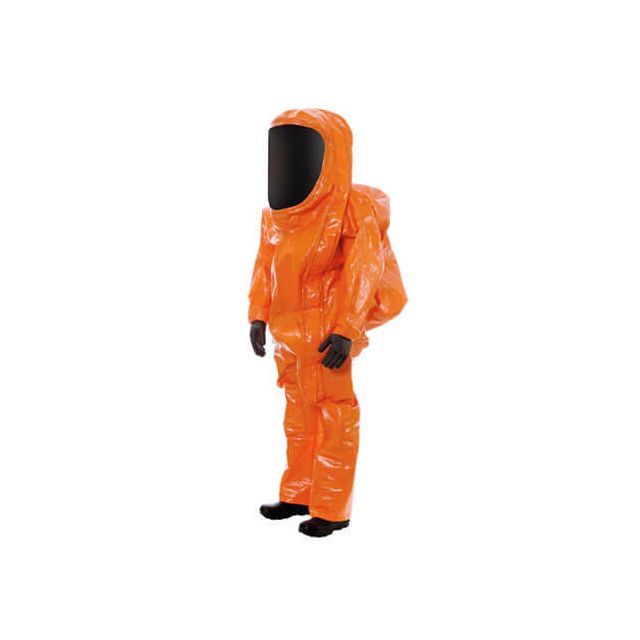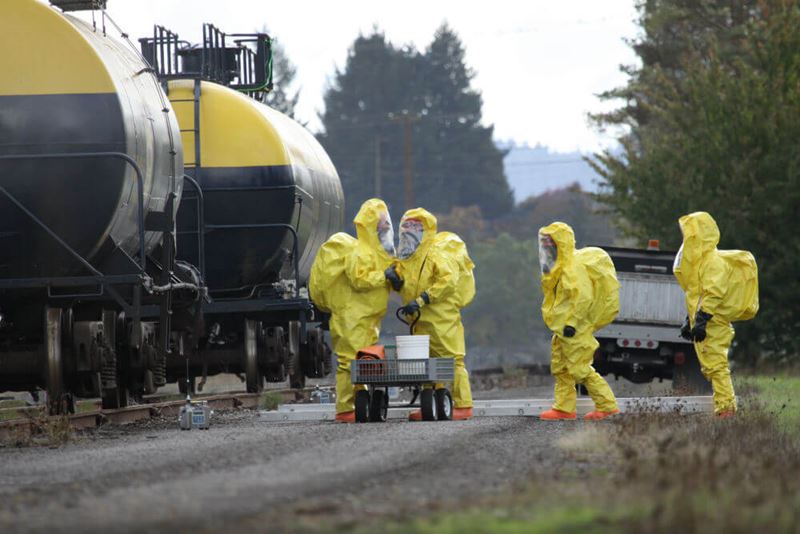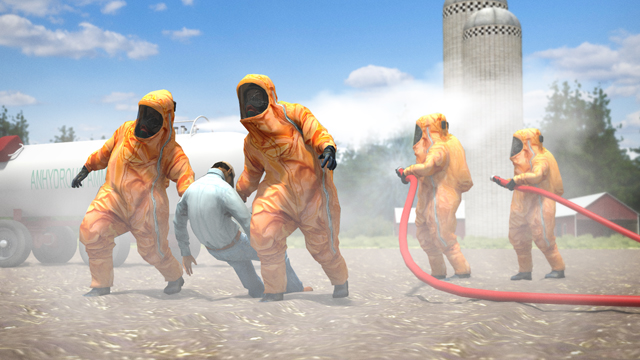【Abstract】This paper systematically sorted out the classification standards of chemical proof suits for fire fighting at the present stage,and summarized the main factors,selection procedures and matters for attention that should be considered in the selection at the scene of chemical accidents.It has certain guiding significance for fire rescue teams to choose chemical proof suits correctly when handling chemical accidents in the future. 【Keywords】 fire fighting;chemical-proof suits; choice; instructions
Introduction
Chemical protective clothing is the fire rescue personnel in the disposal of gaseous, liquid hazardous chemicals and corrosive substances and oxygen deficiency site environment to implement rescue It can effectively avoid the harm caused by various dangerous substances to human body. China is a large producer of hazardous chemicals, and also a large country of hazardous chemical accidents. According to incomplete statistics, 1,314 chemical accidents occurred in 2020, including 148 accidents with more than one death, resulting in 313 deaths. General hazardous chemical accident site toxic and harmful gases, corrosive liquid flow, frame collapse, pits everywhere, such as the “3-21” Jiangsu Ringshui explosion, involving the surrounding 1.2km² of 16 enterprises and a sewage collection station martyrdom explosion, the site left 1020 risk sources, the center of the accident due to the explosion formed a diameter In the face of similar accidents, firefighters and rescue workers who do not wear various types of chemical protective clothing correctly are bound to cause erosion of chemicals on themselves.
In order to better promote the fire rescue team, especially the petrochemical accident disposal heavy formations among them, master the use of various types of chemical protective clothing. environment and taboos, improve the scientific, safety and environmental protection of accident disposal, this paper will focus on the classification of chemical protective clothing, applicable occasions, the main factors and procedures to be considered for selection and use, as well as precautions.

1.Classification of chemical protective clothing
At present, domestic and international standards involving chemical protective clothing can be divided into five categories: First, the U.S. standards, mainly refers to a series of standards of the National Fire Protection Association (NFPA), including NFPA 1991 hazardous chemical incidents with gas-tight protective clothing, NFPA 1992 chemical hazmat splash protective clothing, NFPA 1994 chemical, biological, terrorist decorated event scene protective clothing, and protective clothing according to The hazards are divided into four levels: A, B, C and D. Second, the European standard, the protective clothing according to the application scenario is divided into Type1 gas-tight protective clothing (EN943-2), Type2 non-gas-tight protective clothing (EN942-1), Type3 liquid-tight protective clothing (EN14605), Type4 spray-tight protective clothing (EN14605), Type5 protective clothing against solid particles ( ENISO13982-1), Type6 anti-mild chemical liquid splash protective clothing (EN13034), three is the 1S0 standard, 1S0 standard and the European EN standard classification remains basically the same, only in the gas-tight protective clothing less should be first aid Yang with the subdivision of protective clothing. Fourth, China’s national CB standard, China’s standards are generally adopted by the European EN standard classification, mainly divided into four categories, respectively, gas-tight protective clothing, non-gas-tight protective clothing, liquid-tight chemical protective clothing and particulate protective clothing, where the liquid-tight protective clothing is divided into jet liquid-tight protective clothing, jet liquid-tight protective clothing-ET and splash liquid-tight protective clothing. Fifth, the main firefighting GA770-2008 “firefighter chemical protective clothing” standard, the protective clothing is divided into first-class chemical protective clothing and second-class chemical protective clothing. First-class chemical protective clothing is a fully sealed one-piece structure, with positive pressure firefighting air breathing apparatus, cooling devices, firefighter call and communication equipment and other equipment with the use of gas-tight chemical protective clothing, also known as built-in heavy chemical protective clothing, the color is generally yellow. Secondary chemical protective clothing is a one-piece structure, used with external positive pressure firefighting air breathing apparatus, is a liquid-tight chemical protective clothing, also known as light chemical protective clothing, generally red.
2 Chemical protective clothing selection
Hazardous chemical accident sites are often filled with toxic and hazardous, flammable and explosive and corrosive media, fire rescue personnel are always facing the risk of poisoning, room rest, burns, corrosion and falls, etc. In the face of complex and changing site environment, we must always remember the principle of accident disposal procedures first, and firmly grasp the various The main points of the disposal of the ring, while strengthening individual protection, choose a reasonable chemical
Protective clothing.
2.1 Stopping and alerting the site
After receiving the accident alarm, the fire-fighting force should be selected according to the disaster situation. Choose to stop at a distance of 300~500m upwind, after considering the scene of fire, explosion, leakage and development trend. Explosion, leakage and development trend, the dense situation of people around the accident, the water source and surrounding building facilities and the incident weather, wind direction, wind speed and other circumstances, choose 500 ~ 1000m initial alert range. Initial stopping The initial stopping distance and alert range should be adjusted twice depending on the development of the disaster.
2.2 Determination of the danger boundary
After the parking alert is completed, a detection team should be organized to form a competent force, the team generally includes three members, two of whom are holding combustible gas detectors or toxic and hazardous gas detectors, the remaining one carrying pen and paper and markers, from upwind in an inverted triangle formation (before 2 after 1) into the accident site is responsible for concentration detection. While advancing, detecting, according to the media danger area and boundary concentration table, taking into account the wind direction and geographical environment of the scene, placing alert signs until drawing the heavy zone, medium zone, light zone and safety zone boundary range. It should be noted that the entire detection process due to changes in the environment and accident disposal process should be maintained dynamic tracking and monitoring, the specific monitoring frequency and number of times depending on the site pollution conditions.

2.3 Divide the light and heavy danger zone
According to the heavy zone, moderate zone, light zone and safety zone boundary range Delineate the corresponding accident risk zone, the general danger source near the lethal zone, the border with red and white striped warning tape mark. Hazardous source to the boundary of the severe zone Concentration range for the heavy zone, marked with a red caution tape. Boundary of severe zone Concentration range to the border of the moderate zone Concentration range for the moderate risk zone, marked with an orange caution tape. In turn, the light danger zone and the safety zone are marked with yellow and Green caution tape signs. Each alert area should be set up with entrances and exits by safety The staff should strictly implement the graded control, the implementation of real name registration, to be personal protective equipment After the inspection of personal protective equipment qualified on-site rescue personnel to enter in steps.
2.4 Choose the protection level of the site
For hazardous chemical accident leakage, fire, explosion accident site, the incident Rescue personnel should be based on the scene of the leak medium toxicity and site detection to determine the Determine the scope of the light and heavy danger zone, and fully consider the rescue personnel in the toxic environment The actual safety needs of the environment, to determine the appropriate level of protection and protection standards. standard.
Different types of chemical accidents have different characteristics and different hazards.
For the first rescuers to arrive at the scene, special attention should be paid to distinguish different disaster,The selection of chemical protective clothing should follow the general procedure of.

3.The use of chemical protective clothing
3.1 The scope of application of various types of protective clothing should be clarified
All protective clothing should avoid high temperature and open flame and should not be close to the fire. If you need to use them, you should wear fireproof chemical protective clothing or stay away from the fire. When dealing with leaks of high concentration, strong permeable gas or a large amount of organic vapor, the first The first choice is heavy-duty chemical suits. When the accident site requires direct contact with hazardous Heavy-duty chemical suits are recommended when direct contact with hazardous chemicals is required. When dealing with military toxic agents chemicals (mustard gas, sarin, phosgene, chlorine, deuterated, cyanide) Cyanide), it is recommended to choose a suit that meets the requirements of NFPA 1991-2005 Vapor Protection Kit for Hazardous Chemical Accidents” (standard for emergency rescue It is recommended to choose the special protective clothing that meets the standard of NFPA 1991-2005 “Vapor Protection Kit for Hazardous Chemical Accidents” (standard of gas-tight protective equipment for emergency rescue). This type of protective clothing face The material of this type of protective clothing adopts double-layer film composite structure, which has strong resistance to The protective clothing is made of double-layer film composite structure, which has strong resistance to the penetration of dangerous chemicals such as zirconium gas and biotoxicants. It can prevent the penetration of external gases.
3.2 Attention should be paid to the protection time limit of special chemicals in weak parts
The weak point of protection of heavy chemical protective clothing is generally in gloves, boots, face The weak points of protection of heavy duty chemical suits are generally in gloves, boots, masks and seams. When dealing with accidents, direct contact with or condensation in hazardous chemicals should be avoided or minimized. Due to the limitation of fabric material, the protective clothing For specific chemicals (such as acetone, acetonitrile, trichloromethane, ethyl acetate, tetrahydrofuran, etc.) For example, protective boots have a much lower protection time for dichloromethane. For example, the protection boots have an impermeability time of 50min for dichloromethane, while the zipper area has a resistance time of 50min for tetrahydrogen Shaanxi clear anti-permeation time of 26min, gloves to acetone, acetonitrile, acetyl The anti-permeation time of gloves to acetone, acetonitrile, ethyl acetate and tetrahydrofuran is only 9min, 22min min, 17min, 16min, before the accident treatment should confirm the chemical Before dealing with the accident, we should confirm the type of chemicals and not directly contact the dangerous chemicals or reduce the contact time. General situation In general, it is recommended that the wearing time should not exceed 60min or 60min for replacement. Direct contact with hazardous chemicals should be further shortened according to the situation.
3.3 Overprotection and improper protection should be avoided
First-level protection, compared with conventional protection, is at the expense of reducing human agility and increasing physical exertion. If conventional protection combatants can fight for 1h, while the first level of protection when the combatants fight for 20min is already tired and ready. So unnecessary over-protection, will make the combat power consumption increased exponentially, greatly affecting the effectiveness of combat. In addition, protective equipment must be targeted and used throughout, for example, protective respiratory gear can not protect the skin, not to mention the use of a protective gear to deal with all hazardous chemical disposal site. In the time period also can not only focus on the initial and ignore the end, some fire combustion products than the initial medium is more toxic, more hazardous, so protection to the whole process, as long as the core area into the personal protection must be done.
3.4 Should pay attention to the re-use of protective clothing conditions
Chemical protective clothing can generally be divided into three categories: one-time use, limited use and reusable. For single-use chemical protective clothing is generally thin in thickness, which is very easy to be worn and broken by external forces and has limited protective effect. Limited-use chemical protective clothing is mainly for storing protective clothing for future use or in cases where it is still not contaminated and damaged after use. In such cases, re-use should be thoroughly inspected and pressure tested before and after each use. Reusable chemical protective clothing should be inspected for damage after use and should be cleaned for next use according to the criteria for determining the degree of contamination and cleaning instructions provided by the factory. It should be noted that no material can be exposed to chemicals for a long time and repeatedly. Once the protective clothing has been exposed to chemicals its internal structure is bound to change, and scientific assessment should be done for re-activation.
4 Conclusion
Chemical protective clothing is the “last line of defense” for firefighters and rescuers when dealing with hazardous chemical accidents. The scientific and reasonable choice of chemical protective clothing is not only related to the success or failure of accident disposal, but also directly related to the life and health of rescuers. Therefore, in the daily training and use process, special attention should be paid to the use of chemical protective clothing, maintenance, maintenance and disposal procedures of the study to ensure that the first time in the accident disposal to make a reasonable choice and scientific response.
 3M
3M Ansell
Ansell Dellta Plus
Dellta Plus Drager
Drager edelrid
edelrid Honeywell
Honeywell JUTEC
JUTEC lakeland
lakeland MSA
MSA New Pig
New Pig Weldas
Weldas